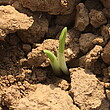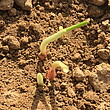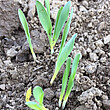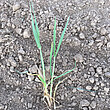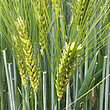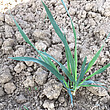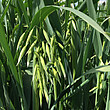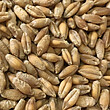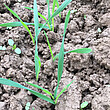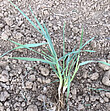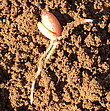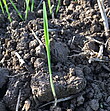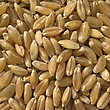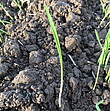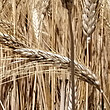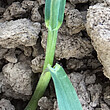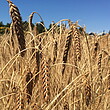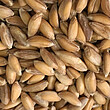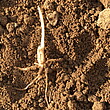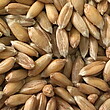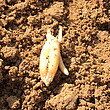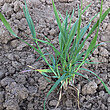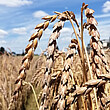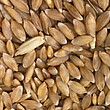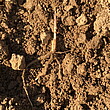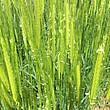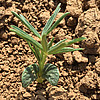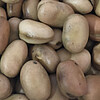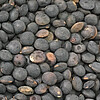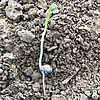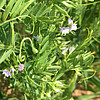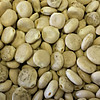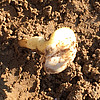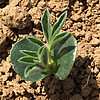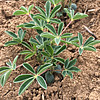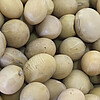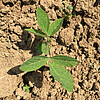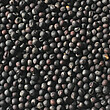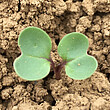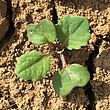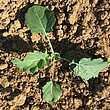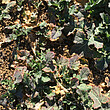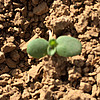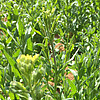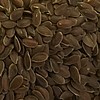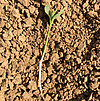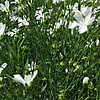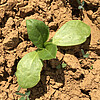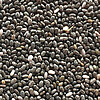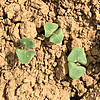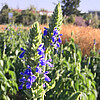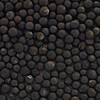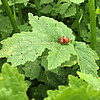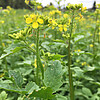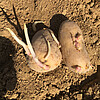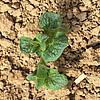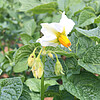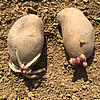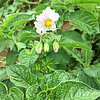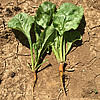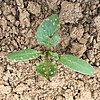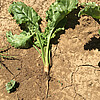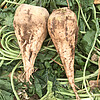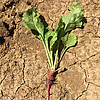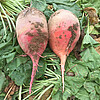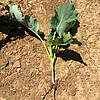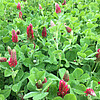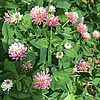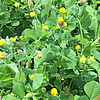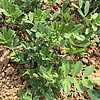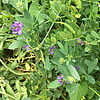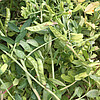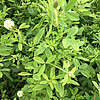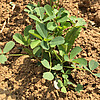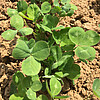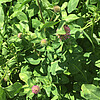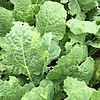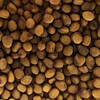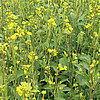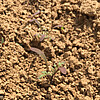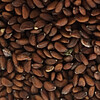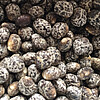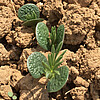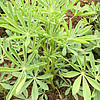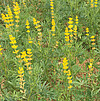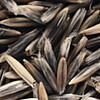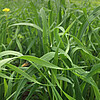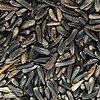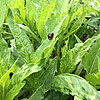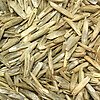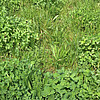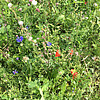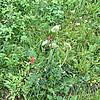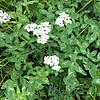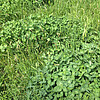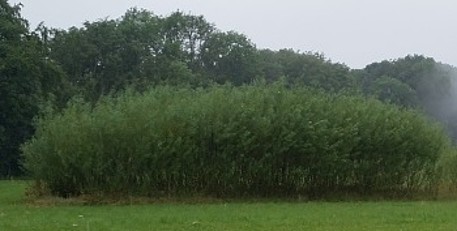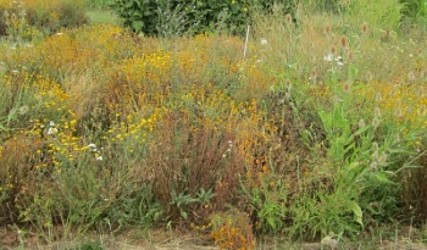Winter types and varieties
Winter feed barley (Hordeum vulgare var. distichon)
Family: True grasses (Poaceae)
Morphological characteristics of barley:
Leaf ears: long, completely enclosing the stem, without cilia
Leaf ligule (Ligula): narrow (1-2 mm), slightly toothed
Infructescence: Spike awned (to 15 cm long), Shapes: two-rowed, multi-rowed, hanging when ripe
Grain: yellow, pointed oval, glumes fused with grain, no whiskers
| Type | Variety | Grains/m² | TKG | KFxFA % | Seed rate kg/ha | Measures | Fertilisation | Plant protection |
|---|---|---|---|---|---|---|---|---|
| Winter feed barley 2-row | SU Laubella | 310 | 56,6 | 98 | 179,0 | Sowing: 02.10.2025 Germination: 14.10.2025
| stained with Vibrance Trio 07.10.2025: Herold SC 0,6 l/ha |
Winter feed barley (Hordeum vulgare var. hexastichon)
Family: True grasses (Poaceae)
Morphological characteristics of barley:
Leaf ears: long, completely enclosing the stem, without cilia
Leaf ligule (Ligula): narrow (1-2 mm), slightly toothed
Infructescence: Spike awned (to 15 cm long), Shapes: two-rowed, multi-rowed, hanging when ripe
Grain: yellow, pointed oval, glumes fused with grain, no whiskers
| Type | Variety | Grains/m² | TKG | KFxFA % | Seed rate kg/ha | Measures | Fertilisation | Plant protection |
|---|---|---|---|---|---|---|---|---|
| Winter feed barley 6-row | Winnie | 280 | 53,0 | 98 | 151,4 | Sowing: 02.10.2025 Germination: 14.10.2025
| not stained 07.10.2025: Herold SC 0,6 l/ha |
Winter malting barley (Hordeum vulgare var. distichon)
Family: True grasses (Poaceae)
Morphological characteristics of barley:
Leaf ears: long, completely enclosing the stem, without cilia
Leaf ligule (Ligula): narrow (1-2 mm), slightly toothed
Infructescence: Spike awned (to 15 cm long), Shapes: two-rowed, multi-rowed, hanging when ripe
Grain: yellow, pointed oval, glumes fused with grain, no whiskers
| Type | Variety | Grains/m² | TKG | KFxFA % | Seed rate kg/ha | Measures | Fertilisation | Plant protection |
|---|---|---|---|---|---|---|---|---|
| Winter malting barley 2-row | KWS Donau | 340 | 48,3 | 98 | 167,6 | Sowing: 02.10.2025 Germination: 14.10.2025
| not stained 07.10.2025: Herold SC 0,6 l/ha |
Winter malting barley (Hordeum vulgare var. hexastichon)
Family: True grasses (Poaceae)
Morphological characteristics of barley:
Leaf ears: long, completely enclosing the stem, without cilia
Leaf ligule (Ligula): narrow (1-2 mm), slightly toothed
Infructescence: Spike awned (to 15 cm long), Shapes: two-rowed, multi-rowed, hanging when ripe
Grain: yellow, pointed oval, glumes fused with grain, no whiskers
| Type | Variety | Grains/m² | TKG | KFxFA % | Seed rate kg/ha | Measures | Fertilisation | Plant protection |
|---|---|---|---|---|---|---|---|---|
| Winter malting barley 6-row | KWS Faro | 320 | 42,3 | 97 | 139,5 | Sowing: 02.10.2025 Germination: 14.10.2025
| not stained 07.10.2025: Herold SC 0,6 l/ha |
Winter oat (Avena sativa)
Family: True grasses (Poaceae)
Morphological characteristics of oat:
Leaf ears: none
Leaf ligule (Ligula): narrow-medium, fringed, toothed
Infructescence: Panicle
Grain: yellow hulled, white hulled or blackhulled, elongated, whiskers on dehusked grain
| Type | Variety | Grains/m² | TKG | KFxFA % | Seed rate kg/ha | Measures | Fertilisation | Plant protection |
|---|---|---|---|---|---|---|---|---|
| Winter oat | KWS Snowbird | 335 | 38,0 | 99 | 128,6 | Sowing: 02.10.2025 Germination: 14.10.2025 | not stained |
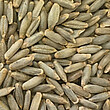

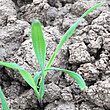
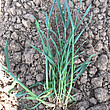
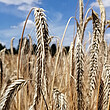
Winter rye (Secale cereale)
Family: True grasses (Poaceae)
Morphological characteristics of Rye:
Leaf auricle: short, not enclosing the stem, not ciliated.
Ligule: narrow, hardly visible
Inflorescence: spike with a border, pendulous
Grain: bluish-green, narrow elongated
| Type | Variety | Grains/m² | TKG | KFxFA % | Seed rate kg/ha | Measures | Fertilisation | Plant protection |
|---|---|---|---|---|---|---|---|---|
| Winter rye (Population) | Dukato | 280 | 43,9 | 92 | 133,6 | Sowing: 02.10.2025 Germination: 14.10.2025 | stained with Vibrance Trio 07.10.2025: Herold SC 0,6 l/ha |
Winter rye (Secale cereale)
Family: True grasses (Poaceae)
Morphological characteristics of Rye:
Leaf auricle: short, not enclosing the stem, not ciliated.
Ligule: narrow, hardly visible
Inflorescence: spike with a border, pendulous
Grain: bluish-green, narrow elongated
| Type | Variety | Grains/m² | TKG | KFxFA % | Seed rate kg/ha | Measures | Fertilisation | Plant protection |
|---|---|---|---|---|---|---|---|---|
| Winter rye (Hybrid) | SU Erling | 230 | 27,6 | 97 | 65,4 | Sowing: 02.10.2025 Germination: 14.10.2025 | stained with: Vibrance Trio 07.10.2025: Herold SC 0,6 l/ha |
Winter triticale (Triticosecale)
Family: True grasses (Poaceae)
Morphological characteristics of triticale:
Leaf auricle: short to medium long, unciliated
Ligule: narrow to medium in size, slightly toothed
Infructescence: Spike awned
Grain: pointed oval
| Type | Variety | Grains/m² | TKG | KFxFA % | Seed rate kg/ha | Measures | Fertilisation | Plant protection |
|---|---|---|---|---|---|---|---|---|
| Winter triticale | Bilboquet | 280 | 37,4 | 94 | 111,4 | Sowing: 02.10.2025 Germination: 14.10.2025 | not stained 16.10.2025 Malibu 4 l/ha |
Winter hybrid wheat (Triticum aestivum)
Familie: True grasses (Poaceae)
Morphological characteristics of wheat:
Leaf auricle: short, not enclosing the stem, ciliated
Ligule: medium size, toothed
Infructescence: Spike not awned and round, exception: awned wheat varieties
Grain: brown-yellow to reddish, oval, medium-length whiskers
| Type | Variety | Grains/m² | TKG | KFxFA % | Seed rate kg/ha | Measures | Fertilisation | Plant protection |
|---|---|---|---|---|---|---|---|---|
Winter wheat (Hybrid) (B) | SU Hybingo | 135 | 52,0 | 92 | 76,3 | Sowing: 15.10.2025 Germination: 31.10.2025 | stained with Vibrance Trio 16.10.2025 Malibu 4 l/ha |
Winter wheat (Triticum aestivum)
Family: True grasses (Poaceae)
Morphological characteristics of wheat:
Leaf ears: short, not enclosing the stem, ciliate
Leaf ligule (Ligula): medium size, serrated
Infructescence: Spike not awned and round, exception: awnded wheat variety
Grain:
| Type | Variety | Grains/m² | TKG | KFxFA % | Seed rate kg/ha | Measures | Fertilisation | Plant protection |
|---|---|---|---|---|---|---|---|---|
| Winter wheat (white) | Alabaster | 340 | 43,0 | 94,1 | 155,4 | Sowing: 15.10.2025 Germination: 31.10.2025 | stained 16.10.2025 Malibu 4 l/ha |
Winter wheat (Triticum aestivum)
Family: True grasses (Poaceae)
Morphological characteristics of wheat:
Leaf auricle: short, not enclosing the stem, ciliate
Ligule: medium size, serrated
Infructescence: Spike awned and round
Grain: brown-yellow to reddish, oval, medium-length whiskers
| Type | Variety | Grains/m² | TKG | KFxFA % | Seed rate kg/ha | Measures | Fertilisation | Plant protection |
|---|---|---|---|---|---|---|---|---|
| Winter wheat (B) (brewing suitability) | SU Mangold | 290 | 49,3 | 94,0 | 152,1 | Sowing: 15.10.2025 Germination: 31.10.2025 | stained 16.10.2025 Malibu 4 l/ha |
Winter malting wheat (Triticum aestivum)
Familie: True grasses (Poaceae)
Morphological characteristics of wheat:
Leaf auricle: short, not enclosing the stem, ciliated
Ligule: medium size, toothed
Infructescence: Spike not awned and round, exception: awned wheat varieties
Grain: brown-yellow to reddish, oval, medium-length whiskers
| Type | Variety | Grains/m² | TKG | KFxFA % | Seed rate kg/ha | Measures | Fertilisation | Plant protection |
|---|---|---|---|---|---|---|---|---|
| Winter wheat (A) awned | KWS Ultim | 320 | 48,1 | 100 | 153,9 | Sowing: 15.10.2025 Germination: 31.10.2025 | not stained 16.10.2025 Malibu 4 l/ha |
Winter durum (Triticum durum)
Familiy: True grasses (Poaceae)
Morphological characteristics Durum wheat:
Leaf auricle: short, not enclosing the stem, ciliated
Ligule: medium sized, toothed
Infructescence: spike with margins, awns up to 20 cm
Grain: glassy, elongated pointed
| Type | Variety | Grains/m² | TKG | KFxFA % | Seed rate kg/ha | Measures | Fertilisation | Plant protection |
|---|---|---|---|---|---|---|---|---|
| Winter durum | Wintergold | 390 | 44,2 | 91 | 210,9 | Sowing: 15.10.2025 Germination: 31.10.2025 | not stained 16.10.2025 Malibu 4 l/ha |
Emmer (Triticum dioccum)
Family: True grasses (Poaceae)
Morphological characteristics of Emmer:
Leaf auricle: large, ciliated
Ligule: medium sized, blunt toothed
Infructescence: Spike awned, drooping
Grain: 2 grains in a glume (vese), brown-yellow, elongated oval, whiskers
| Type | Variety | Grains/m² | TKG | KFxFA % | Seed rate kg/ha | Measures | Fertilisation | Plant protection |
|---|---|---|---|---|---|---|---|---|
| Emmer | Späths Albjuwel | 320 | 55,2 | 86,4 | 204,4 | Sowing: 15.10.2025 Germination: 31.10.2025 | not stained 16.10.2025 Malibu 4 l/ha |
Emmer (Triticum dioccum)
Family: True grasses (Poaceae)
Morphological characteristics of Emmer:
Leaf auricle: large, ciliated
Ligule: medium sized, blunt toothed
Infructescence: Spike awned, drooping
Grain: 2 grains in a glume (vese), brown-yellow, elongated oval, whiskers
| Type | Variety | Grains/m² | TKG | KFxFA% | Seed rate kg/ha | Measures | Fertilisation | Plant protection |
|---|---|---|---|---|---|---|---|---|
| Emmer | Roter Heidfelder | 320 | 46,1 | 80,8 | 182,7 | Sowing: 15.10.2025 Germination: 31.10.2025 | not stained 16.10.2025 Malibu 4 l/ha |
Spelt (Triticum aestivum ssp. spelta)
Family: True grasses (Poaceae)
Morphological characteristics of spelt:
Leaf auricles: medium in size (not enclosing culm), partly ciliated
Ligule: short, toothed
Inflorescence: spike without awns, hanging
Grain: 2-3 grains in an enveloping glume (vese), reddish-brown
| Type | Variety | Grains/m² | TKG | KFxFA% | Seed rate kg/ha | Measures | Fertilisation | Plant protection |
|---|---|---|---|---|---|---|---|---|
| Spelt | Zollernfit | 275 | 57,1 | 99 | 158,6 | Sowing: 15.10.2025 Germination: 31.10.2025 | not stained |
Einkorn (Triticum monococcum)
Family: True grasses (Poaceae)
Morphological characteristics of Einkorn:
Leaf auricle: short, ciliated
Ligule: medium sized, blunt toothed
Infructescence: Spike awned, upright
Grain: 1 grain in a glume (vese), brown-yellow, elongated oval
| Type | Variety | Grains/m² | TKG | KFxFA % | Seed rate kg/ha | Measures | Fertilisation | Plant protection |
|---|---|---|---|---|---|---|---|---|
| Einkorn | Monoverde | 280 | 33,8 | 82,8 | 114,3 | Sowing: 15.10.2025 Germination: 31.10.2025 | not stained 16.10.2025 Malibu 4 l/ha |
Einkorn (Triticum monococcum)
Family: True grasses (Poaceae)
Morphological characteristics of Einkorn:
Leaf auricle: short, ciliated
Ligule: medium sized, blunt toothed
Infructescence: Spike awned, upright
Grain: 1 grain in a glume (vese), brown-yellow, elongated oval
| Type | Variety | Grains/m² | TKG | KFxFA % | Seed rate kg/ha | Measures | Fertilisation | Plant protection |
|---|---|---|---|---|---|---|---|---|
| Einkorn | Monomax | 280 | 28,2 | 77,4 | 102,0 | Sowing: 15.10.2025 Germination: 31.10.2025 | not stained 16.10.2025 Malibu 4 l/ha |
Types and varieties
Lupin (Lupinus angustifolius)
Familie: Legume (Fabaceae)
| Type | Variety | Grains/m² | TKG | KF % | Seed rate kg/ha | Measures | Fertilisation | Plant protection |
|---|---|---|---|---|---|---|---|---|
| Lupin blue | Carabor | 80 | 157,0 | 94 | 133,6 | Sowing: 06.03.2025 Germination: 01.04.2025 | 15.04.2025 Interrow Cultivator Harrow |
Field bean (Vicia faba)
Family: Legume (Fabaceae)
| Type | Variety | Grains/m² | TKG | KF % | Seed rate kg/ha | Measures | Fertilisation | Plant protection |
|---|---|---|---|---|---|---|---|---|
| Field bean | Birgit | 50 | 600,0 | 97 | 309,3 | Sowing: 06.03.2025 Germination: 04.04.2025 | 15.04.2025 Interrow Cultivator Harrow |
Pea (Pisum sativum)
Family: Legume (Fabaceae)
| Type | Variety | Grains/m² | TKG | KF % | Seed rate kg/ha | Measures | Fertilisation | Plant protection |
|---|---|---|---|---|---|---|---|---|
| Pea | Texas | 80 | 300,0 | 99 | 151,5 | Sowing: 06.03.2025 Germination: 04.04.2025 | 15.04.2025 Interrow Cultivator Harrow |
Lentil (Lens culinaris)
Family: Legum (Fabaceae)
| Type | Variety | Grains/m² | TKG | KF % | Seed rate kg/ha | Measures | Fertilisation | Plant protection |
|---|---|---|---|---|---|---|---|---|
| Lentil | Anicia | 225 | 50,3 | 96,0 | 118 (75%) | Sowing: 07.04.2025 Germination: 23.04.2025 | I Harrow: Interrow Cultivator: | |
| Supporting crop Oat | Lion | 75 | 41,8 | 96,0 | 32,7 (25%) | Sowing: 07.04.2025 Germination: 23.04.2025 | Harrow: Interrow Cultivator: |
Lupin (Lupinus albus)
Family: Legume (Fabaceae)
| Type | Variety | Grains/m² | TKG | KF % | Seed rate kg/ha | Measures | Fertilisation | Plant protection |
|---|---|---|---|---|---|---|---|---|
| Lupin white | Celina | 80 | 444,8 | 100 | 355,8 | Sowing: 06.03.2025 Germination: 04.04.2025 | 15.04.2025 Interrow Cultivator Harrow |



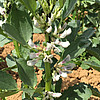
Faba bean (Vicia faba)
Family: Legume (Fabaceae)
| Type | Variety | Grains/m² | TKG | KF % | Seed rate kg/ha | Measures | Fertilisation | Plant protection |
|---|---|---|---|---|---|---|---|---|
| Field bean | Callas | 50 | 602,0 | 95 | 316,8 | Sowing: 06.03.2025 Germination: 04.04.2025 | 15.04.2025 Interrow Cultivator Harrow |
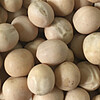

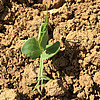
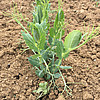

Pea (Pisum sativum)
Family: Legume (Fabaceae)
| Type | Variety | Grains/m² | TKG | KF % | Seed rate kg/ha | Measures | Fertilisation | Plant protection |
|---|---|---|---|---|---|---|---|---|
| Pea | Astronaute | 80 | 240 | 97 | 197,9 | Sowing: 06.03.2025 Germination: 04.04.2025 | 15.04.2025 Interrow Cultivator Harrow |
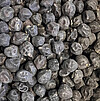
Chickpea (Cicer arietinum)
Family: Legume (Fabaceae)
| Type | Variety | Grains/m² | TKG | KF % | Seed rate kg/ha | Measures | Fertilisation | Plant protection |
|---|---|---|---|---|---|---|---|---|
| Chickpea | Elmo | 60 | 278 | 90 | 185,3 | Sowing: 21.05.2025 Germination: | Harrow: Interrow Cultivator: |
Soybean (Glycine max)
Family: Legume (Fabaceae)
| Type | Variety | Grains/m² | TKG | KF % | Seed rate kg/ha | Measures | Fertilisation | Plant protection |
|---|---|---|---|---|---|---|---|---|
| Soybean | Arnold | 55 | 198,2 | 94 | 116,0 | Sowing: 29.04.2025 Germination: | Inoculation with: |
Winter types and varieties
Winter rape (Brassica napus)
Family: Cruciferous (Brassicaceae)
| Type | Variety | Grains/m² | TKG | KFxFA % | Seed rate kg/ha | Measures | Fertilisation | Plant protection |
|---|---|---|---|---|---|---|---|---|
| Winter rape (Hybrid) | Ambassador | 50 | 6,4 | 88,2 | 3,3 | Sowing: 26.08.2025 Cambridge roller: 26.08.2025 Germination: 09.09.2025 Reseed: 02.10.2025 Germination: 21.10.2025
| not stained 07.10.2025 Butisan Gold 2,5 l/ha |
Winter rape KWS Ambos
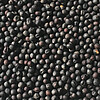
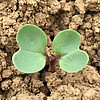

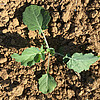
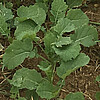


Winter rape (Brassica napus)
Family: Cruciferous (Brassicaceae)
| Type | Variety | Grains/m² | TKG | KFxFA % | Seed rate kg/ha | Measures | Fertilisation | Plant protection |
|---|---|---|---|---|---|---|---|---|
| Winter rape (Hybrid) | KWS Ambos | 55 | 5,13 | 79,9 | 3,0 | Sowing: 26.08.2025 Cambridge roller: 26.08.2025 Germination: 09.09.2025 Ressed: 02.10.2025 Germination: 21.10.2025
|
| stained with: Scenic Gold, Lumiposa 07.10.2025 Butisan Gold 2,5 l/ha
|
Winter rape (Brassica napus)
Family: Cruciferous (Brassicaceae)
| Type | Variety | Grains/m² | TKG | KFxFA % | Seed rate kg/ha | Measures | Fertilisation | Plant protection |
|---|---|---|---|---|---|---|---|---|
| Winter rape (Linie) | Arabella | 60 | 4,71 | 86,4 | 2,9 | Sowing: 26.08.2025 Cambridge roller: 26.08.2025 Germination: 09.09.2025 Ressed: 02.10.2025 Germination: 21.10.2025
|
| not stained 07.10.2025 Butisan Gold 2,5 l/ha |
Winter rape (Brassica napus)
Family: Cruciferous (Brassicaceae)
| Type | Variety | Grains/m² | TKG | KFxFA % | Seed rate kg/ha | Measures | Fertilisation | Plant protection |
|---|---|---|---|---|---|---|---|---|
| Winter rape (Linie) | Randy | 70 | 4,8 | 81,9 | 3,7 | Sowing: 26.08.2025 Cambridge roller: 26.08.2025 Germination: 09.09.2025 Ressed: 02.10.2025 Germination: 21.10.2025
|
| stained 07.10.2025 Butisan Gold 2,5 l/ha |
Spring types and varieties
Camelina (Camelina sativa)
Family: Cruciferous (Brassicaceae)
| Type | Variety | Grains/m² | TKG | KF % | Seed rate kg/ha | Measures | Fertilisation | Plant protection |
|---|---|---|---|---|---|---|---|---|
| Camelina | Zuzanna | 500 | 0,9 | 93 | 4,9 | Sowing: 08.04.2025 Cambridge roller: 08.04.2025 Germination: 19.04.2025
| 23.04.2025 60 kg N/ha (Entec 26%) | not treated
|
Safflower (Carthamus tinctorius)
Familie: Composite (Asteraceae)
| Type | Variety | Grains/m² | TKG | KF % | Seed rate kg/ha | Measures | Fertilisation | Plant protection |
|---|---|---|---|---|---|---|---|---|
| Safflower | 90 | 37,7 | 83,7 | 40,5 | Sowing: 08.04.2025 Cambridge roller: 08.04.2025 Germination: 19.04.2025 | 23.04.2025 60 kg N/ha (Entec 26%) | not treated |
Chia (Salvia hispanica)
Family: Labiate (Lamiaceae)
Variety: Juana
| Type | Variety | Grains/m² | TKG | KF % | Seed rate kg/ha | Measures | Fertilisation | Plant protection |
|---|---|---|---|---|---|---|---|---|
| Chia | Juana | 70 | Sowing: 21.05.2025 Germination: | not treated Interrow Cultivator: |
Types and varieties
Potato (Solanum tuberosum)
Family: Solanum (Solanaceae)
Cooking type: waxy
| Art | Variety | Tuber/m² | Measures | Fertilisation | Plant protection |
|---|---|---|---|---|---|
| Potato, medium early | Emiliana | 4 | Plantation: 11.04.2025 Sprout: 13.05.2025 | 08.05.2025 100 kg N/ha (Entec 26%) | 15.04.2025 VA 2,0 l/ha Bandur + 2 kg/ha Artist Heap dams: 28.05.2025 |
Potato (Solanum tuberosum)
Family: Solanum (Solanaceae)
Cooking type: predominantly waxy
| Art | Variety | Tuber/m² | Measures | Fertilisation | Plant protection |
|---|---|---|---|---|---|
| Potato, early | Red Sonja | 4 | Plantation: 11.04.2025 Sprout: 13.05.2025 | 08.05.2025 100 kg N/ha (Entec 26%) | 15.04.2025 VA 2,0 l/ha Bandur + 2 kg/ha Artist Heap dams: 28.05.2025 |
Potato (Solanum tuberosum)
Family: Solanum (Solanaceae)
Cooking type: mealy
| Art | Variety | Tuber/m² | Measures | Fertilisation | Plant protection |
|---|---|---|---|---|---|
| Potato, medium early | Karelia | 4 | Plantation: 11.04.2025 Sprout: 13.05.2025 | 08.05.2025 100 kg N/ha (Entec 26%) | 15.04.2025 VA 2,0 l/ha Bandur + 2 kg/ha Artist Heap dams: 28.05.2025 |
Fodder beet (Beta vulgaris subsp. vulgaris)
Family: Amaranths (Amaranthaceae)
| Type | Variety | Grains/m² | TKG | KF % | Seed rate kg/ha | Measures | Fertilisation | Plant protection |
|---|---|---|---|---|---|---|---|---|
| Fodder beet | Feldherr | 10 | Sowing: 22.04.2025 Germination: 09.05.2025 | 08.05.2025 80 kg N/ha (Entec 26%) | 20.05.2025 2,0 l/ha Betanal, 1,5 l/ha Goltix, 0,6 l/ha Oblix |
Sugar beet (Beta vulgaris subsp. altissima)
Family: Amaranths (Amaranthaceae)
| Type | Variety | Grains/m² | TKG | KF % | Seed rate kg/ha | Measures | Fertilisation | Plant protection |
|---|---|---|---|---|---|---|---|---|
| Sugar beet (Feadbeet) | Calledia KWS | 10 | Sowing: 22.04.2025 Germination: 09.05.2025 | 08.05.2025 80 kg N/ha (Entec 26%) | 20.05.2025 2,0 l/ha Betanal, 1,5 l/ha Goltix, 0,6 l/ha Oblix |
Fodder (Energy) beet (Beta vulgaris subsp. vulgaris)
Family: Amaranths (Amaranthaceae)
| Type | Variety | Grains/m² | TKG | KF % | Seed rate kg/ha | Measures | Fertilisation | Plant protection |
|---|---|---|---|---|---|---|---|---|
| Fodder (Energy) beet | Ribambelle | 10 | Sowing: 22.04.2025 Germination: 09.05.2025 | 08.05.2025 80 kg N/ha (Entec 26%) | 20.05.2025 2,0 l/ha Betanal, 1,5 l/ha Goltix, 0,6 l/ha Oblix |
Marrow-stem kale (Brassica oleracea var. medullosa)
Family: Cruciferous (Brassicaceae)
| Type | Variety | Grains/m² | TKG | KF % | Seed rate kg/ha | Measures | Fertilisation | Plant protection |
|---|---|---|---|---|---|---|---|---|
| Marrow- stem kale | Inka | 110 | 4,4 | 95 | 4,3 | Sowing: 22.04.2025 Germination: 09.05.2025 | 08.05.2025 80 kg N/ha (Entec 26%) | Interrow Cultivator: |
Types and varieties
Crimson clover (Trifolium incarnatum)
Family: Legume (Fabaceae)
| Type | Variety | Seed rate kg/ha | Measures | Fertilistion | Plant protection |
|---|---|---|---|---|---|
| Crimson clover | Heusens Ostsaat | 30 | Sowing: 08.04.2025 Cambridge roller: 08.04.2025 Germination: 05.05.2025 |
Persian clover (Trifolium resupinatum)
Family: Legume (Fabaceae)
| Type | Variety | Seed rate kg/ha | Measures | Fertilistion | Plant protection |
|---|---|---|---|---|---|
| Persian clover | Pasat | 20 | Sowing: 08.04.2025 Cambridge roller: 08.04.2025 Germination: 05.05.2025 |
Alsike clover (Trifolium hybridum)
Family: Legume (Fabaceae)
| Type | Variety | Seed rate kg/ha | Measures | Fertilistion | Plant protection |
|---|---|---|---|---|---|
| Alsike clover | Lomiai | 20 | Sowing: 08.04.2025 Cambridge roller: 08.04.2025 Germination: 05.05.2025 |
|
Black medick (Medicago lupulina)
Family: Legume (Fabaceae)
| Type | Variety | Seed rate kg/ha | Measures | Fertilistion | Plant protection |
|---|---|---|---|---|---|
| Black medick | Ekola | 20 | Sowing: 08.04.2025 Cambridge roller: 08.04.2025 Germination: 05.05.2025 |
Summer - Common vetch (Vicia sativa)
Family: Legume (Fabaceae)
| Type | Variety | Seed rate kg/ha | Measures | Fertilation | Plant protection |
|---|---|---|---|---|---|
| Summer - Common vetch | Ebena | 120 | Sowing: 08.04.2025 Cambridge roller: 08.04.2025 Germination: 05.05.2025 |
Berseem clover (Trifolium alexandrium)
Family: Legume (Fabaceae)
| Type | Variety | Seed rate kg/ha | Measures | Fertilistion | Plant protection |
|---|---|---|---|---|---|
| Berseem clover | Winner | 35 | Sowing: 08.04.2025 Cambridge roller: 08.04.2025 Germination: 05.05.2025 |
Types and Varieties
Catch crop mixtures
Honey plants anual
| Type | Seed rate kg/ha | Measures | Fertilation |
|---|---|---|---|
| 25% Phacelia (Phacelia tanacetifolia) | 10 | Sowing: 09.04.2025 Cambridge roller: 09.04.2025 Germination: 05.05.2025 | |
| 5% Cornflower (Centaurea cyanus) | |||
| 5% Marigold (Calendula officinalis) | |||
| 2,5% Red poppy (Papaver rhoeas) | |||
| 5% Dill (Anethum graveolens) | |||
| 2,5% Black cumin (Nigella sativa) | |||
| 7,5% Safflower (Carthamus tinctorius) | |||
| 10% Sunflower (Helianthus annuus) | |||
| 5% Coriander (Coriandrum sativum) | |||
| 10% Serradella (Ornithopus sativus) | |||
| 2,5% Bokhara clover (Melilotus albus) | |||
| 12,5% Crimson clover (Trifolium incarnatum) | |||
| 7,5% Persian clover (Trifolium resupinatum) |
Catch crop mixture
TerraLife Warm Season
| Type | Seed rate kg/ha | Measures | Fertilation |
|---|---|---|---|
| 37% Common vetch (Vicia sativa) | 30 | Sowing: 09.04.2025 Cambridge roller: 09.04.2025 Germination: 05.05.2025 | |
| 15% Öil linseed (Linum usitatissimum) | |||
| 15% Sorghum (Shorghum) | |||
| 13% Berseem clover (Trifolium alexandrinum) | |||
| 8% Ramtilla (Guizotia abyssinica) | |||
| 8% Safflower (Carthamus tinctorius) | |||
| 4% Abyssinian mustard (Brassica carinata) |
Types and varieties
Hybrid ryegrass (Lolium x hybridum)
Family: True grasses (Poaceae)
| Type | Variety | TKG | KF % | Purity % | Seed rate kg/ha | Measures | Fertilisation | Plant protection |
|---|---|---|---|---|---|---|---|---|
Hybrid ryegrass | Rusa | 3,42 | 95 | 100 | 42,0 (by pure seed) | Sowing: 05.03.2025 | 23.04.2025 60 kg N/ha (KAS 27) |
Tall fescue (Festuca arundinacea)
Family: True grasses (Poaceae)
| Type | Variety | TKG | KF % | Purity % | Seed rate kg/ha | Measures | Fertilisation | Plant protection |
|---|---|---|---|---|---|---|---|---|
Tall fescue | Maksi | 2,94 | 97 | 98,8 | 30,3 (by pure seed) | Sowing: 05.03.2025 | 23.04.2025 60 kg N/ha (KAS 27) |
Cocksfoot gras (Dactylis glomerata)
Family: True grasses (Poaceae)
| Type | Variety | TKG | KF % | Purity % | Seed rate kg/ha | Measures | Fertilisation | Plant protection |
|---|---|---|---|---|---|---|---|---|
Cocksfoot grass | Lyra | 1,09 | 93 | 99,8 | 25,0 (20-25 by pure seed) | Sowing: 05.03.2025 | 23.04.2025 60 kg N/ha (KAS 27) |
Meadow foxtail (Alopecurus pratensis)
Family: True grasses (Poaceae)
| Type | Variety | TKG | KF % | Purity % | Seed rate kg/ha | Measures | Fertilisation | Plant protection |
|---|---|---|---|---|---|---|---|---|
Meadow foxtail | Alopex | 1,04 | 91 | 99,8 | 25,1 (by pure seed | Sowing: 05.03.2025 | 23.04.2025 60 kg N/ha (KAS 27) |
Golden oat grass (Trisetum flavescens)
Family: True grasses (Poaceae)
| Type | Variety | TKG | KF % | Purity % | Seed rate kg/ha | Measures | Fertilisation | Plant protection |
|---|---|---|---|---|---|---|---|---|
Golden oat grass | Trisett 51 | 0,2 | 70 | 93 | 20,0 (by pure seed) | Sowing: 05.03.2025 | 23.04.2025 60 kg N/ha (KAS 27) |
Meadow fescue (Festuca pratensis)
Family: True grasses (Poaceae)
| Type | Variety | TKG | KF % | Purity % | Seed rate kg/ha | Measures | Fertilisation | Plant protection |
|---|---|---|---|---|---|---|---|---|
Meadow fescue | Pardus | 2,15 | 94 | 99,1 | 25,2 (by pure seed) | Sowing: 05.03.2025 | 23.04.2025 60 kg N/ha (KAS 27) |
Red fescue (Festuca rubra)
Family: True grasses (Poaceae)
| Type | Variety | TKG | KF % | Purity % | Seed rate kg/ha | Measures | Fertilisation | Plant protection |
|---|---|---|---|---|---|---|---|---|
Red fescue | Reverent | 1,22 | 91 | 99,6 | 27,5 (by pure seed 25 - 40) | Sowing: 05.03.2025 | 23.04.2025 60 kg N/ha (KAS 27) |
Kentucky blue grass (Poa pratensis)
Family: True grasses (Poaceae)
| Type | Variety | TKG | KF % | Purity % | Seed rate kg/ha | Measures | Fertilisation | Plant protection |
|---|---|---|---|---|---|---|---|---|
Kentucky blue grass | Kupol | 0,19 | 80 | 100 | 23,2 (15 - 20 by pure seed) | Sowing: 05.03.2025 | 23.04.2025 60 kg N/ha (KAS 27) |
Timothy (Phleum pratense)
Family: True grasses (Poaceae)
| Type | Variety | TKG | KF % | Purity % | Seed rate kg/ha | Measures | Fertilisation | Plant protection |
|---|---|---|---|---|---|---|---|---|
| Timothy | Polarking | 0,42 | 90 | 99,9 | 22,4 | Sowing: 05.03.2025 | 23.04.2025 60 kg N/ha (KAS 27) |
Tall oatgrass (Arrhenatherum elatius)
Family: True grasses (Poaceae)
| Type | Variety | TKG | KF % | Purity % | Seed rate kg/ha | Measures | Fertilisation | Plant protection |
|---|---|---|---|---|---|---|---|---|
Tall oatgrass | Arone | 2,9 | 80 | 99 | 40 | Sowing: 05.03.2025 | 23.04.2025 60 kg N/ha (KAS 27) |
Demonstration Experiment Grassland intensity
Herb-rich grass mixture Fertilisation 1
Herb-rich grass mixture extensive use
2 cuts, 0 kg N/ha - Fertilisation
| Type | Seed rate kg/ha | Sowing | Fertilisation | Measures |
|---|---|---|---|---|
| 30 | 09.04.2021 | no fertilisation | Cambridge roller: 09.04.2021 Harvest first cut: |
| Flowers 30% |
| Types in the mixture | Family | Proportion in the mix % |
|---|---|---|
Common yarrow (Achillea millefolium) | Composite (Asteraceae) | 1,0 |
Wild beaked parsley (Anthriscus sylvestris) | Umbellifer (Apiaceae) | 0,5 |
Rambling Bellflower (Campanula patula) | Campanula (Campanulaceae) | 0,1 |
Caraway (Carum carvi) | Umbellifer (Apiaceae) | 2,5 |
| Cornflower (Centaurea cyanus) | Composite(Asteraceae) | 2,0 |
| Brown knapweed (Centaurea jacea) | Composite (Asteraceae) | 2,0 |
| Raugh hawksbeard (Crepis biennis) | Composite (Asteraceae) | 0,7 |
| Wild carrot (Daucus carota) | Umbellifer (Apiaceae) | 1,8 |
| White bedstraw (Galium album) | Bedstraw (Rubiaceae) | 2,0 |
| Hogweed (Heracleum sphondylium) | Umbellifer (Apiaceae) | 0,4 |
| Field scabiosa (Knautia arvensis) | Honeysuckle (Caprifoliaceae) | 1,0 |
| Raugh hawkbit (Leontodon hispidus) | Composite (Asteraceae) | 0,3 |
| Common daisy (Leucanthemum ircutianum/vulgare) | Composite (Asteraceae) | 2,5 |
| Birds-foot trefoil (Lotus corniculatus) | Legume (Fabaceae) | 1,2 |
| Cuckoo flower (Lychnis flos-cuculi) | Pinks (Caryophyllaceae) | 0,5 |
| Musk mallow (Malva moschata) | Mallow (Malvaceae) | 0,5 |
| Red poppy (Papaver rhoeas) | Poppy (Papaveraceae) | 1,0 |
| Great burnet-saxifrage (Pimpinella major) | Umbellifer (Apiaceae) | 0,4 |
| Buckhorn (Plantago lanceolata) | Plantain (Plantaginaceae) | 2,5 |
| Common self-heal (Prunella vulgaris) | Mint (Lamiaceae) | 1,3 |
| Common sorrel (Rumex acetosa) | Knotweed (Polygonaceae) | 0,8 |
| Meadow clary (Salvia pratensis) | Mint (Lamiaceae) | 1,0 |
| Great burnet (Sanguisorba officinalis) | Rose (Rosaceae) | 0,4 |
| Autumn hawkbit (Scorzoneroides autumnalis) | Composite (Asteraceae) | 0,3 |
| Red campion (Silene dioica) | Pinks (Caryophyllaceae) | 0,5 |
| Meadow salsify (Tragopogon pratensis) | Composite (Asteraceae) | 1,2 |
| Bladder campion (Silene vulgaris) | Pinks (Caryophyllaceae) | 1,0 |
| Red clover (Trifolium pratense) | Legume (Fabaceae) | 0,6 |
| Grasses 70% |
| Types in the mixture | Family | Proportion in the mix % |
|---|---|---|
Common bent grass (Agrostis capillaris) | True grasses (Poaceae) | 2,0 |
Yellow foxtail grass (Alopecurus pratensis) | True grasses (Poaceae) | 3,0 |
Buffalo grass (Anthoxanthum odoratum) | True grasses (Poaceae) | 4,0 |
Tall oatgrass (Arrhenatherum elatius) | True grasses (Poaceae) | 2,0 |
| Barley brome (Bromus hordeaceus) | True grasses (Poaceae) | 4,0 |
| Crested dogtail grass (Cynosurus cristatus) | True grasses (Poaceae) | 5,0 |
| Cocksfoot grass (Dactylis glomerata) | True grasses (Poaceae) | 2,0 |
| Meadow fescue (Festuca pratensis) | True grasses (Poaceae) | 8,0 |
| Red fescue (Festuca rubra) | True grasses (Poaceae) | 17,0 |
| Downy oatgrass (Helictotrichon pubescens) | True grasses (Poaceae) | 2,0 |
| Perennial ryegrass (Lolium perenne) | True grasses (Poaceae) | 5,0 |
| Narrow-leaved meadow grass (Poa angustifolia) | True grasses (Poaceae) | 13,0 |
| Golden oatgrass (Trisetum flavescens) | True grasses (Poaceae) | 3,0 |
Herb-rich grass mixture extensive use
2 cuts, 30 kg N/ha - Fertilisation
| Type | Seed rate kg/ha | Sowing | Fertilisation | Measures |
|---|---|---|---|---|
| 30 | 09.04.2021 | KAS (27%) 30 kg N/ha: 27.03.2025 | Cambridge roller: 09.04.2021 Harvest first cut: |
| Flowers 30% |
| Types in the mixture | Family | Proportion in the mix % |
|---|---|---|
Common yarrow (Achillea millefolium) | Composite (Asteraceae) | 1,0 |
Wild beaked parsley (Anthriscus sylvestris) | Umbellifer (Apiaceae) | 0,5 |
Rambling Bellflower (Campanula patula) | Campanula (Campanulaceae) | 0,1 |
Caraway (Carum carvi) | Umbellifer (Apiaceae) | 2,5 |
| Cornflower (Centaurea cyanus) | Composite(Asteraceae) | 2,0 |
| Brown knapweed (Centaurea jacea) | Composite (Asteraceae) | 2,0 |
| Raugh hawksbeard (Crepis biennis) | Composite (Asteraceae) | 0,7 |
| Wild carrot (Daucus carota) | Umbellifer (Apiaceae) | 1,8 |
| White bedstraw (Galium album) | Bedstraw (Rubiaceae) | 2,0 |
| Hogweed (Heracleum sphondylium) | Umbellifer (Apiaceae) | 0,4 |
| Field scabiosa (Knautia arvensis) | Honeysuckle (Caprifoliaceae) | 1,0 |
| Raugh hawkbit (Leontodon hispidus) | Composite (Asteraceae) | 0,3 |
| Common daisy (Leucanthemum ircutianum/vulgare) | Composite (Asteraceae) | 2,5 |
| Birds-foot trefoil (Lotus corniculatus) | Legume (Fabaceae) | 1,2 |
| Cuckoo flower (Lychnis flos-cuculi) | Pinks (Caryophyllaceae) | 0,5 |
| Musk mallow (Malva moschata) | Mallow (Malvaceae) | 0,5 |
| Red poppy (Papaver rhoeas) | Poppy (Papaveraceae) | 1,0 |
| Great burnet-saxifrage (Pimpinella major) | Umbellifer (Apiaceae) | 0,4 |
| Buckhorn (Plantago lanceolata) | Plantain (Plantaginaceae) | 2,5 |
| Common self-heal (Prunella vulgaris) | Mint (Lamiaceae) | 1,3 |
| Common sorrel (Rumex acetosa) | Knotweed (Polygonaceae) | 0,8 |
| Meadow clary (Salvia pratensis) | Mint (Lamiaceae) | 1,0 |
| Great burnet (Sanguisorba officinalis) | Rose (Rosaceae) | 0,4 |
| Autumn hawkbit (Scorzoneroides autumnalis) | Composite (Asteraceae) | 0,3 |
| Red campion (Silene dioica) | Pinks (Caryophyllaceae) | 0,5 |
| Meadow salsify (Tragopogon pratensis) | Composite (Asteraceae) | 1,2 |
| Bladder campion (Silene vulgaris) | Pinks (Caryophyllaceae) | 1,0 |
| Red clover (Trifolium pratense) | Legume (Fabaceae) | 0,6 |
| Grasses 70% |
| Types in the mixture | Family | Proportion in the mix % |
|---|---|---|
Common bent grass (Agrostis capillaris) | True grasses (Poaceae) | 2,0 |
Yellow foxtail grass (Alopecurus pratensis) | True grasses (Poaceae) | 3,0 |
Buffalo grass (Anthoxanthum odoratum) | True grasses (Poaceae) | 4,0 |
Tall oatgrass (Arrhenatherum elatius) | True grasses (Poaceae) | 2,0 |
| Barley brome (Bromus hordeaceus) | True grasses (Poaceae) | 4,0 |
| Crested dogtail grass (Cynosurus cristatus) | True grasses (Poaceae) | 5,0 |
| Cocksfoot grass (Dactylis glomerata) | True grasses (Poaceae) | 2,0 |
| Meadow fescue (Festuca pratensis) | True grasses (Poaceae) | 8,0 |
| Red fescue (Festuca rubra) | True grasses (Poaceae) | 17,0 |
| Downy oatgrass (Helictotrichon pubescens) | True grasses (Poaceae) | 2,0 |
| Perennial ryegrass (Lolium perenne) | True grasses (Poaceae) | 5,0 |
| Narrow-leaved meadow grass (Poa angustifolia) | True grasses (Poaceae) | 13,0 |
| Golden oatgrass (Trisetum flavescens) | True grasses (Poaceae) | 3,0 |
Herb-rich grass mixture extensive use
2 cuts, 60 kg N/ha - Fertilisation
| Type | Seed rate kg/ha | Sowing | Fertilisation | Measures |
|---|---|---|---|---|
| 30 | 09.04.2021 | KAS (27%) 60 kg N/ha: 27.03.2025 | Cambridge roller: 09.04.2021 Harvest first cut: |
| Flowers 30% |
| Types in the mixture | Family | Proportion in the mix % |
|---|---|---|
Common yarrow (Achillea millefolium) | Composite (Asteraceae) | 1,0 |
Wild beaked parsley (Anthriscus sylvestris) | Umbellifer (Apiaceae) | 0,5 |
Rambling Bellflower (Campanula patula) | Campanula (Campanulaceae) | 0,1 |
Caraway (Carum carvi) | Umbellifer (Apiaceae) | 2,5 |
| Cornflower (Centaurea cyanus) | Composite(Asteraceae) | 2,0 |
| Brown knapweed (Centaurea jacea) | Composite (Asteraceae) | 2,0 |
| Raugh hawksbeard (Crepis biennis) | Composite (Asteraceae) | 0,7 |
| Wild carrot (Daucus carota) | Umbellifer (Apiaceae) | 1,8 |
| White bedstraw (Galium album) | Bedstraw (Rubiaceae) | 2,0 |
| Hogweed (Heracleum sphondylium) | Umbellifer (Apiaceae) | 0,4 |
| Field scabiosa (Knautia arvensis) | Honeysuckle (Caprifoliaceae) | 1,0 |
| Raugh hawkbit (Leontodon hispidus) | Composite (Asteraceae) | 0,3 |
| Common daisy (Leucanthemum ircutianum/vulgare) | Composite (Asteraceae) | 2,5 |
| Birds-foot trefoil (Lotus corniculatus) | Legume (Fabaceae) | 1,2 |
| Cuckoo flower (Lychnis flos-cuculi) | Pinks (Caryophyllaceae) | 0,5 |
| Musk mallow (Malva moschata) | Mallow (Malvaceae) | 0,5 |
| Red poppy (Papaver rhoeas) | Poppy (Papaveraceae) | 1,0 |
| Great burnet-saxifrage (Pimpinella major) | Umbellifer (Apiaceae) | 0,4 |
| Buckhorn (Plantago lanceolata) | Plantain (Plantaginaceae) | 2,5 |
| Common self-heal (Prunella vulgaris) | Mint (Lamiaceae) | 1,3 |
| Common sorrel (Rumex acetosa) | Knotweed (Polygonaceae) | 0,8 |
| Meadow clary (Salvia pratensis) | Mint (Lamiaceae) | 1,0 |
| Great burnet (Sanguisorba officinalis) | Rose (Rosaceae) | 0,4 |
| Autumn hawkbit (Scorzoneroides autumnalis) | Composite (Asteraceae) | 0,3 |
| Red campion (Silene dioica) | Pinks (Caryophyllaceae) | 0,5 |
| Meadow salsify (Tragopogon pratensis) | Composite (Asteraceae) | 1,2 |
| Bladder campion (Silene vulgaris) | Pinks (Caryophyllaceae) | 1,0 |
| Red clover (Trifolium pratense) | Legume (Fabaceae) | 0,6 |
| Grasses 70% |
| Types in the mixture | Family | Proportion in the mix % |
|---|---|---|
Common bent grass (Agrostis capillaris) | True grasses (Poaceae) | 2,0 |
Yellow foxtail grass (Alopecurus pratensis) | True grasses (Poaceae) | 3,0 |
Buffalo grass (Anthoxanthum odoratum) | True grasses (Poaceae) | 4,0 |
Tall oatgrass (Arrhenatherum elatius) | True grasses (Poaceae) | 2,0 |
| Barley brome (Bromus hordeaceus) | True grasses (Poaceae) | 4,0 |
| Crested dogtail grass (Cynosurus cristatus) | True grasses (Poaceae) | 5,0 |
| Cocksfoot grass (Dactylis glomerata) | True grasses (Poaceae) | 2,0 |
| Meadow fescue (Festuca pratensis) | True grasses (Poaceae) | 8,0 |
| Red fescue (Festuca rubra) | True grasses (Poaceae) | 17,0 |
| Downy oatgrass (Helictotrichon pubescens) | True grasses (Poaceae) | 2,0 |
| Perennial ryegrass (Lolium perenne) | True grasses (Poaceae) | 5,0 |
| Narrow-leaved meadow grass (Poa angustifolia) | True grasses (Poaceae) | 13,0 |
| Golden oatgrass (Trisetum flavescens) | True grasses (Poaceae) | 3,0 |
Grass mixture intensive use
4 cuts, 0 kg N/ha - Fertilisation
| Type | Seed rate kg/ha | Sowing | Fertilisation | Measures |
|---|---|---|---|---|
GSWU - Cutting and grazing use | 30 | 09.04.2021 | no fertilisation | Cambridge roller: 09.04.2021 Harvest first cut: 28.05.2025 |
| Types in the mixture | Family | Proportion in the mix % |
|---|---|---|
Perennial ryegras (Lolium perenne) | True grasses (Poaceae) | 6,0 |
Meadow fescue (Festuca pratensis) | True grasses (Poaceae) | 28,0 |
Timothy (Phleum pratense) | True grasses (Poaceae) | 17,0 |
Kentucky blue grass (Poa pratensis) | True grasses (Poaceae) | 14,0 |
| Yellow foxtail grass (Alopecurus pratensis) | True grasses (Poaceae) | 6,0 |
| Red fescue (Festuca rubra) | True grasses (Poaceae) | 11,0 |
| Cocksfoot grass (Dactylis glomerata) | True grasses (Poaceae) | 6,0 |
| White clover (Trifolium repens) | Legume (Fabaaceae) | 9,0 |
| Red clover (Trifolium pratense) | Legume (Fabaaceae) | 3,0 |
Grass mixture intensive use
4 cuts, 30 kg N/ha - Fertilisation
| Type | Seed rate kg/ha | Sowing | Fertilisation | Measures |
|---|---|---|---|---|
GSWU - Cutting and grazing use | 30 | 09.04.2021 | KAS (27%) 30 kg N/ha: 27.03.2025 | Cambridge roller: 09.04.2021 Harvest first cut: 28.05.2025 |
| Types in the mixture | Family | Proportion in the mix % |
|---|---|---|
Perennial ryegras (Lolium perenne) | True grasses (Poaceae) | 6,0 |
Meadow fescue (Festuca pratensis) | True grasses (Poaceae) | 28,0 |
Timothy (Phleum pratense) | True grasses (Poaceae) | 17,0 |
Kentucky blue grass (Poa pratensis) | True grasses (Poaceae) | 14,0 |
| Yellow foxtail grass (Alopecurus pratensis) | True grasses (Poaceae) | 6,0 |
| Red fescue (Festuca rubra) | True grasses (Poaceae) | 11,0 |
| Cocksfoot grass (Dactylis glomerata) | True grasses (Poaceae) | 6,0 |
| White clover (Trifolium repens) | Legume (Fabaaceae) | 9,0 |
| Red clover (Trifolium pratense) | Legume (Fabaaceae) | 3,0 |
Grass mixture intensive use
4 cuts, 60 kg N/ha - Fertilisation
| Type | Seed rate kg/ha | Sowing | Fertilisation | Measures |
|---|---|---|---|---|
GSWU - Cutting and grazing use | 30 | 09.04.2021 | KAS (27%) 60 kg N/ha: 27.03.2025 | Cambridge roller: 09.04.2021 Harvest 1. cut: 28.05.2025 |
| Types in the mixture | Family | Proportion in the mix % |
|---|---|---|
Perennial ryegras (Lolium perenne) | True grasses (Poaceae) | 6,0 |
Meadow fescue (Festuca pratensis) | True grasses (Poaceae) | 28,0 |
Timothy (Phleum pratense) | True grasses (Poaceae) | 17,0 |
Kentucky blue grass (Poa pratensis) | True grasses (Poaceae) | 14,0 |
| Yellow foxtail grass (Alopecurus pratensis) | True grasses (Poaceae) | 6,0 |
| Red fescue (Festuca rubra) | True grasses (Poaceae) | 11,0 |
| Cocksfoot grass (Dactylis glomerata) | True grasses (Poaceae) | 6,0 |
| White clover (Trifolium repens) | Legume (Fabaaceae) | 9,0 |
| Red clover (Trifolium pratense) | Legume (Fabaaceae) | 3,0 |
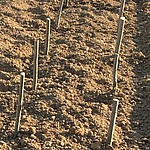
Willow (Salix)
Family: Willow family (Salicaceae)
| Type | Plants / m² | Plantation | Fertilisation | Measures |
|---|---|---|---|---|
Willow | 16 (Double row 40cm) Plant rows spacing 120 cm | 26.02.2019 | 23.03.2021 60 kg N/ha (KAS 27%) KAS (27%) 60 kg N/ha: 15.03.2022 KAS (27%) 60 kg N/ha: 23.03.2023 KAS (27%) 60 kg N/ha: 21.03.2024 KAS (27%) 60 kg N/ha: 27.03.2025 | Interrow Cultivator: 17.03.2020 Interrow Cultivator: 14.04.2020 14.02.2024 1. harvest |
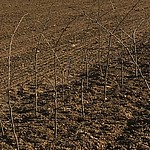
Poplar (Populus)
Family: Willow family (Salicaceae)
| Type | Plants / m² | Plantation | Fertilisation | Measures |
|---|---|---|---|---|
Poplar | 16 (Double row40cm) Plant rows spacing 120 cm | 26.02.2019 | 23.03.2021 60 kg N/ha (KAS 27%) KAS (27%) 60 kg N/ha: 14.03.2022 KAS (27%) 60 kg N/ha: 23.03.2023 KAS (27%) 60 kg N/ha: 21.03.2024 KAS (27%) 60 kg N/ha: 27.03.2025 | Interrow Cultivator: 17.03.2020 14.02.2024 1. harvest |
Miscanthus (Miscanthus x giganteus)
Family: True Grasses (Poaceae)
| Type | Plants / m² | Plantation | Fertilisation | Measures |
|---|---|---|---|---|
Miscanthus | 2 | April 2019 | 24.03.2020 60 kg N/ha (KAS 27%) 23.03.2021 60 kg N/ha (KAS 27%) KAS (27%) 60 kg N/ha: 14.03.2022 KAS (27%) 60 kg N/ha: 23.03.2023 KAS (27%) 60 kg N/ha: 21.03.2024 KAS (27%) 60 kg N/ha: 27.03.2025 | Interrow Cultivator: 14.04.2020 |
Switchgrass (Panicum virgatum)
Family: True grasses (Poaceae)
| Type | Plants / m² | Plantation | Fertilisation | Measures |
|---|---|---|---|---|
Switchgrass | 10 | 20.03.2019 | 24.03.2020 60 kg N/ha (KAS 27%) 23.03.2021 60 kg N/ha (KAS 27%) KAS (27%) 60 kg N/ha: 14.03.2022 KAS (27%) 60 kg N/ha: 23.03.2023 KAS (27%) 60 kg N/ha: 21.03.2024 KAS (27%) 60 kg N/ha: 27.03.2025 | Interrow Cultivator: 07.04.2020 |
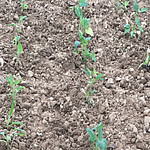

Cup plant (Silphium perfoliatum)
Family: Composite (Asteraceae)
| Type | Plants / m² | Plantation | Fertilisation | Measures |
|---|---|---|---|---|
Cup plant | 4 | April 2019 | 24.03.2020 60 kg N/ha (KAS 27%) 23.03.2021 60 kg N/ha (KAS 27%) KAS (27%) 60 kg N/ha: 14.03.2022 KAS (27%) 60 kg N/ha: 23.03.2023 KAS (27%) 60 kg N/ha: 21.03.2024 KAS (27%) 60 kg N/ha: 27.03.2025 | Interrow Cultivator: 24.03.2020 |
Wild and cultivated plant mix
Biogas BG 90 - perennial
Seed mix for biogas production
Sowing: April 2019
Seed rate: 10 kg/ha (Seeding aid in the mixture 30%)
| Types in the mixture | Proportion in the mix % | Fertilisation | Measures | |
|---|---|---|---|---|
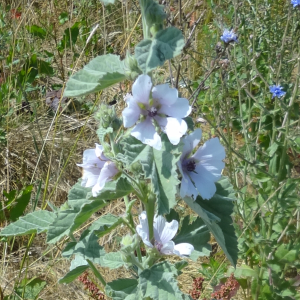 | Marsh mallow (Althaea officinalis) Family: Mallow (Malvaceae) | 7,5 | 23.03.2021 60 kg N/ha (KAS 27%) KAS (27%) 60 kg N/ha: 14.03.2022 KAS (27%) 60 kg N/ha: 23.03.2023 KAS (27%) 60 kg N/ha: 21.03.2024 KAS (27%) 60 kg N/ha: 27.03.2025 | Harrow: 06.04.2020 |
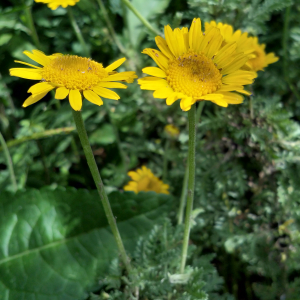 | Yellow chamomile (Anthemis tinctoria) Family: Composite (Asteraceae) | 1,5 | ||
 | Mugwort (Artemisia vulgaris) Family: Composite (Asteraceae) | 0,5 | ||
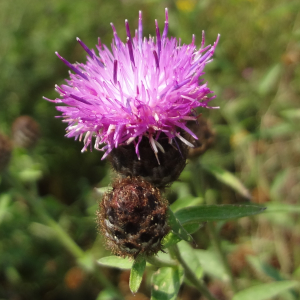 | Black knapweed (Centaurea nigra) Family: Composite (Asteraceae) | 7,0 | ||
 | Blue sailors (Cichorium intybus) Family: Composite (Asteraceae) | 1,5 | ||
 | Eastern carrot (Daucus carota) Family: Umbellifer (Apiceae) | 0,5 | ||
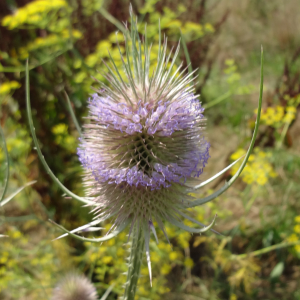 | Wild teasel (Dipsacus sylvestris) Family: Honeysuckle (Caprifoliaceae) | 0,5 | ||
 | Blueweed (Echium vulgare) Family: Heliotrope (Boraginaceae) | |||
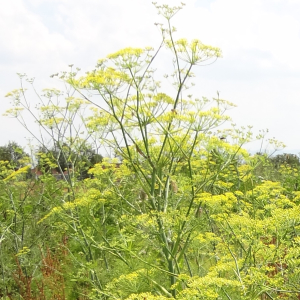 | Fennel (Foeniculum vulgare) Family: Umbellifer (Apiceae) | 3,5 | ||
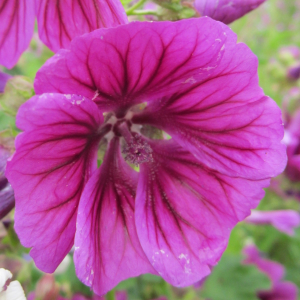 | Mauritania mallow (Malva sylvestris var. mauritania) Family: Mallow (Malvaceae) | 3,5 | ||
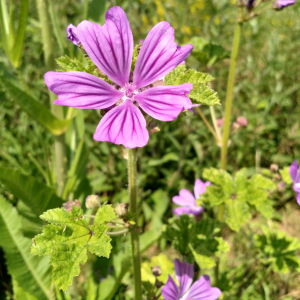 | Common mallow (Malva sylvestris) Family: Mallow (Malvaceae) | 6,0 | ||
 | Lucerne (Medicago sativa) Family: Legume (Fabaceae) | 2,0 | ||
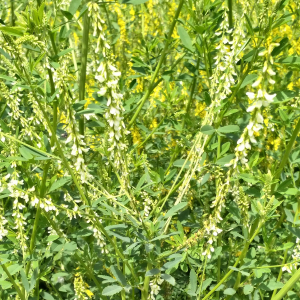 | Bokhara clover (Melilotus albus) Family: Legume (Fabaceae) | 5,0 | ||
Yellow sweet clover (Melilotus officinalis) Family: Legume (Fabaceae) | 5,0 | |||
Sainfoin (Onobrychis viciifolia) Family: Legume (Fabaceae) | 8,0 | |||
Yellow weed (Reseda luteola) Family: Migonette (Resadaceae) | 0,3 | |||
White campion (Silene latifolia alba) Family: Pinks (Caryophyllaceae) | 1,0 | |||
Red campion (Silene dioica) Family: Pinks (Caryophyllaceae) | 1,0 | |||
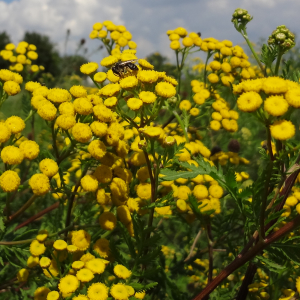 | Tansy (Tanacetum vulgare) Family: Composite (Asteraceae) | 5,0 | ||
 | Mullein (Verbascum) Family: Figwort (Scrophulariaceae) | 0,2 |




